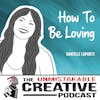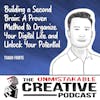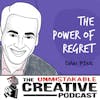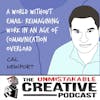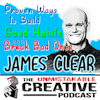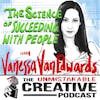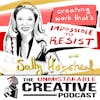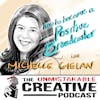Chloé Nwangwu | Engineering Visibility: A Behavioral Science Approach to Branding Part 2
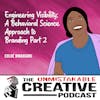
Explore advanced branding strategies with Chloe Nwangwu in 'Engineering Visibility: A Behavioral Science Approach to Branding Part 2' on The Unmistakable Creative Podcast.
In the second installment of 'Engineering Visibility: A Behavioral Science Approach to Branding' on The Unmistakable Creative Podcast, we continue our enlightening conversation with Chloe Nwangwu. Building on the insights from Part 1, Chloe dives deeper into the advanced components of behavioral science and its systematic application in branding.
Listeners will gain a deeper understanding of Chloe's proprietary brand positioning to design mapping protocol, exploring its potential to transform branding strategies. Through real-world applications and case studies, Chloe elucidates how behavioral science can be harnessed to drive brand performance, influence public perception, and achieve desired outcomes.
Join us for this compelling continuation, as we delve into the future of branding through the lens of behavioral science, exploring its potential to revolutionize the way brands communicate and connect with their audiences.
Subscribe for ad-free interviews and bonus episodes https://plus.acast.com/s/the-unmistakable-creative-podcast.
Hosted on Acast. See acast.com/privacy for more information.
Srini Rao : In the first part of our conversation, you and I talked about this idea of visibility engineering conceptually. We touched on this whole idea of how we create an impression and manage influence effectively. And right as we were about to wrap up the conversation, you left an open loop, which made me realize there's no way that we couldn't do this in two parts. Let's talk about how we actually put this into action because, last time I think what we were really talking about was data gathering which I think that's the part that actually most of us, do well, that's easy, but then it's putting that into action that I think really is where, a lot of people run into trouble.
Chloe Nwangu: Yeah. Great. Great. Yeah. So what I would say to that is a couple of things, right? I think first things first, the reason putting all of that data that we are gathering into action and being it brings in subpar results, I might say excuse me, is largely because the models that we are dealing with are how to put this kindly outdated, not based off of what we know about human behavior, take your pick. And I could point to like specific things, but okay, maybe I shall, maybe I will. Yeah, that would be helpful. Yeah, so you know how you folks will do market research, essentially, or some variation of us, right? Quant or qualitative, and then they'll pour all of that information into niching, let's say, right? Now the problem, a bunch of problems with niching, but one of the key problems is that it's not, it doesn't pay attention to or equip the people who are using it for behavior training, right? That's not its goal, really. And. Behavior change ultimately is the thing that we are trying to do, right? So niching as a tool for behavior change is obsolete. So that's an example of the kind of thing that typically folks will do and then they end up running into trouble. I think another issue with niching is that again, and we've spoken about context and how important that is, but that it can't, it doesn't really adjust to context very well. It's not super flexible, right? Like you set it and forget it. And that's the whole idea, Behavior doesn't work that way because the environments around us that generate and spark and inspire our behaviors don't work that way. So that's what I would say in terms of why folks end up running into trouble. In terms of how we can avoid this, I'd say two things. And I may or may not have brought this up in our previous conversation, but Really focusing on motivation, right? Focusing on motivational drivers, this things in the environment that are generating our motivations. And using those two things almost to replace niching, right? Replacing niching or however we want to select an intended audience, right? Replacing niching with something that takes into consideration not only the core motivations that people have but the actual drivers in the environment that you as an organization, as a person, whatever it happens to be, are specifically positioned to address, right? So replacing niching and other sort of targeting tactics. with something like that. I have my own version of this, right? So I could talk about it, but I won't bore folks with that. But generally those are the building blocks of what I have seen works and succeeds. Yeah.
Srini Rao : I think that you and I touched on context a little bit, and I felt like I had to, pull up this quote from Trevor Noah that I heard it was on his last episode of The Daily Show. And I ended up transcribing it because I just thought it was so poignant. He said, I feel like we live in an age of limitless information right now, but we never seem to acknowledge that there's a shortage of context. And it's in many ways why I started doing between the scenes, I realized that In the short time I have on the show, there's only so much I can convey as a message. And that message is distilled and synthesized for people, but we process everything in bytes and we don't realize that we have a lot of information, but we don't have the context that is necessary for us to protect, to process that information, which is so important. Context is everything. It's truly everything. And, and yet, yeah, the thing that, we're talking about niching is so often we start with quantitative data and. Context, I feel like, is this invisible layer that you really can't get from quantitative data. So how do you account for that in this process?
Chloe Nwangu: I have, in the course of developing my theory of practice I've come up with some shortcuts or things that I use to do this, right? So usually I will do a couple of different analyses to help me pick up on this invisible layer that you're talking about. The first is something that I call a matters most analysis. And essentially what that is doing or is forcing me to do. Is to, excuse me is to understand the chain of motivations that people tend to have, right? This is something that I have observed that when folks tend to struggle when they're talking about what they do or, drawing in the right sorts of people, any sort of problem that tends to come from communicating, right? Often it's because they're trying to communicate more than one motivation at the same time. And what folks don't realize is that our motivations actually exist in a sequential chain. And so what this matters most analysis forces me to do as a practitioner is to stop and say, okay what are all the motivations that I am equipped to support this person with? How do they like, what is the impact narrative is what I call that sequence or that chain of motivations. But what is the, chronological sequence of motivations that exists here, right? Which one of these things has to happen first before all the others and then which has to happen after that first one, but before everything else, right? Going through that process and then borrowing from what behavioral science has to say about the things that we pay attention to, given the various kinds of context we find ourselves in, right? And so I know, for example, that if I'm dealing with a certain kind of person and their world looks a certain kind of way, that they're going to be hyperbolically discounting really intensely. And so that means that they're going to be paying closer attention to The earlier parts of that motivational chain or that impact narrative versus the later part, whereas somebody who is in a different environment has different motivational drivers. Maybe they are looking to improve something, right? Rather than like fixing something. Maybe they're looking to improve something. Those folks tend to be focused on the later parts of that chain, right? So I've developed lots of little analyses and things like this that force me to pull in the context so that I always have it at hand when I'm going about the work that I do. Does that answer your question in any way? At Arizona State University, we're committed to our students success. That's why we've designed our online courses to utilize adaptive technology for enhanced learning. Explore more than 300 programs online from the nation's most innovative university. Visit asuonline. asu.
Srini Rao : edu. Today's episode is brought to you by King's College London, an institution with nearly 200 years of impact, renowned for its world leading research and commitment to addressing the real issues facing humanity today. As a podcast host and author and someone who's always been driven by curiosity and inquisitiveness, I find myself deeply resonating with the King's mindset. Their mindset is all about not just accepting the world as it is, but actively asking questions to change it, to shape it into something better. Will AI stunt human creativity, or will it serve as a key to unlock our true creative potential? These are the types of questions that I often ponder in my own work as a creative professional who leverages AI daily. They're the same kinds of questions that students at King's College London will interrogate in their academic journey. The Digital Futures Institute at King's is taking on some of the most pressing problems of our current age. Their mission? To help us create better, more equitable digital futures. They're reframing what are usually thought of as purely technical challenges as human and social challenges. King's College London is the place to go if you want to make a real difference in the world. They partner with government and industries to provide global solutions that make a tangible difference. They're not just about theoretical knowledge, but practical, impactful solutions. Every change starts with a question. Find the right questions at King's. Search King's College London, accept our question today. Regardless of the type of work you do, your space impacts everything from your productivity to your creativity to your well being. Ikea thinks that everyone should be able to create their dream home without putting their finances and future in jeopardy. By being an ally for those with tighter budgets, Ikea helps you furnish your home with beautiful and innovative products so that you feel a greater sense of pride in your home. When you shop at Ikea, every dollar gives you more. More quality, more sustainability, more inspiration, and when all these things come together, you can make the most of every day. Ikea has solutions to everyday challenges to make your home work better for you and make your home feel more you for less. Explore more at ikea usa. com. Again, that's ikea usa. com. It does, but I like, I want to make it a bit more concrete. So let's just use a real life example. So I surveyed data from, having surveyed our email list about, what their goals, their interests are with utilizing generative AI for creative work. Based on, whatever questions I've let's just look at that sort of as a place. And typically what I'll ask them is, what are your big challenges? What are your obstacles? And what do you want to be able to do in a very simplified, dumbed down version? Sure. So using that sort of as a jump off point, how would we apply what you just said to that? Yeah, totally.
Chloe Nwangu: Yeah, no, absolutely. So what I would do is I would take all of that information, especially that last question. That last question is actually super helpful. And I'd say, okay, cool, these constitute the sort of mechanical might not be the right word, but like the things that people want to be able to do, right? Or overcome or avoid or, like whatever it happens to be, right? These represent the things that people want to do, right? Then you want to take it up a level and say, okay, cool, what kind of person do they have to be in order for them to be able to do these things, right? And that's just coming from the behavioral science principle that when you label somebody as a thing, you're more likely to affect their behavior. And so you find what that label happens to be like, who it is they have to be in order to allow for that to happen. Once you have that, and I tend to call them B goals, right? Once you have your list of B goals, Then what I will do is I will put them in sequential order, right? What has to happen first before any of these other things, right? Which what B goal do they need to meet before any of these other ones are possible, right? And continue to do them until we get to the last one. And then that's when I'll do the kind of analysis that I was talking about, saying, okay, behaviorally based off what this data has already told me, are they, is hyperbolic discounting something that's going on here? Are they looking more towards the future? Is this something in the middle? And what does that mean in terms of how we want to frame? the relevant B goal, right? So that's usually what that will look like. Just super quickly, super intimately. And I have, yeah, sorry,
Srini Rao : go ahead. So as I understand it, so basically what you're doing is categorizing these people into groups and saying, okay, what type of person do they need to be to achieve X, Y, Z goal? And then, what's needed to become that type of person?
Chloe Nwangu: Yeah, so I'll get even more specific, right? And that the groups that I organized them into before this analysis happens is based off of motivations, right? What is motivating them? You'll tend to find certain groups or segments of motivations within the data that you've collected certain kinds of motivation. So once you've done that, Then I do this analysis that I just spoke about for each of those groups of motivations, right? And that then allows me to say, okay, cool. This is the impact narrative, right? This is the sequential chain of motivations that this person needs to go through to hit all these people that they want. And based off of what I know about how the brain works, about how behavior works, how cognitive biases work, this is going to be the most salient set of beagles for them. And this is going to be the best way to frame those beagles. And that's just one analysis out of like maybe five or
Srini Rao : six. Yeah. So that's the first step. So let's go into the next
Chloe Nwangu: one. Oh my gosh. We could be here all day. We haven't even gotten into the influence. Gosh give
Srini Rao : us the soundbite versions. We'll, we'll put together something for our listeners so they can. Sure.
Chloe Nwangu: So that's the first level of sort of contextual analysis that I tend to do looking for motivational drivers, right? The others, it will depend again based off of stuff, right? But usually you're looking the kinds of resources that they are dealing with, right? And how much of those resources they have or. feel like they have, right? Because perception is really key here. Another kind of analysis that I tend to do is looking where they fall on something that I've been calling colloquially in my head as the investment index, right? But Just in terms of how much they have invested in the relevant eagles that we just spoke about, where do they fall on a scale of just getting started essentially to to we're looking to refine our approach to doing this thing, right? And there's a whole bunch of. underlying information that we can get once we place them somewhere on that scale. Gosh, I'm trying to think what kinds of analyses do I do? Yeah I'll do an assessment of their mental models, right? Basically, when it comes to the relevant set of eagles that we're talking about, how do they think the world works, right? Figuring that out. So like things like that, right? I will do those kinds of analyses, probably more depend but I'll do analyses like that. And that allows me to have on hand that sort of invisible layer of context that you were talking about. And that information is so key. What I tend to find is that folks will, especially the folks that I tend to work with, right? They'll be in a situation where they think that things are secure. And that's largely because they have an active audience, they have offers that people are interested in or people are volunteering to be part of the organization. They have an active board or active set of donors, like whatever that happens to be, like that behavioral thing that they. are looking to have and continue to maintain, right? Like they have that thing and while it's not perfect and like exactly where they'd want it to be and isn't maybe scaling quickly as they would like, they have that thing and they feel like that's the floor beneath which they can't or won't fall generally barring something insane, right? But what I've found often, and I find myself saying this a lot, is that what you have there is actually stability. It's not security. Security is stability across time, right? And in order to have that, you need to be able to remain hyper relevant across contexts, right? And so that means even when we have a pandemic and the flu calls out from under us and there's a big R word or, recession, because I'm not afraid of it. Like even when the, the world feels like it is ending, that is context. That's a possible context that is within the realm of possibility. And if you are not equipped. or don't have a system in place for shifting how you do things, right? Like how you manage your influence and how you manage your, the impression that you give and communicate, right? If you don't have a tool or means of managing those things, even in that context, then what you have is stability, not security. And so that's why this invisible layer of context that you've been talking about is so key because it becomes then the foundation for that framework or that system that allows you to shift pretty fluently between contexts, right? Anyway.
Srini Rao : Let's get into the influence piece, and then let's think about this from the standpoint. First, let's define what influence is because like I have always joked, I was like, influencers don't influence shit as far as I'm concerned, other than their own egos. I'm sorry, having a million followers on Instagram doesn't qualify you as an influencer. A mother who works three jobs to put food on the table for her kids is more of an influencer agree than some person who basically puts up, hundreds of selfies of themselves.
Chloe Nwangu: Not to hate on content creators at all, but yes I, Yeah, no,
Srini Rao : I, but I think that the idea of influence is often conf, like people confuse influence and impact
Chloe Nwangu: in my opinion. Agreed.
Srini Rao : Yeah. So let's define influence from your perspective first, because I think we have to start with a definition.
Chloe Nwangu: Yeah, I agree. And this is something that is currently in flux for me. So take it with a grain of salt. But I do connect it to the definition that I think I gave you last time we spoke about what a brand is, right? Which is just a system of ideas that influences the behavior of other people, right? Or a type of system of ideas, right? Not all such systems of ideas are a brand and so forth. So when I'm talking about influencing and influencing behavior, I'm talking about the ability to affect how someone develops, how they act or how they think. That's the working definition that I have right now. But that is something that I'm keeping an eye on in terms of where tweaks may need to be made, but that's the working definition that I have right now.
Srini Rao : So let's talk about using, what we've got so far based on everything you've said to start, actually creating influence and whether that is, getting somebody to buy a product, getting somebody to subscribe to a newsletter, getting somebody to tell a friend about what you've
Chloe Nwangu: created. Yeah, absolutely. So this is where I cannot fangirl hard enough over. But I will try. And again, the man has almost no idea who I am. I think we spoke over email once and he was very kind. But this is where network analysis becomes. Key and very interesting, right? The idea here is that once you have all of this impression stuff that we've been talking about up until now developed and managed, right? And able to be managed across contacts, right? Then what you want to do is start designing your network for behavior change. And I say this for two reasons, one, because everything that we've been talking about I'm more donate here, all of that, all of those behavior change getting someone to go from not doing that to doing that behavior change but also because when we're talking about the context of folks who are under recognized, which is something that I brought up briefly before and visibility biases and all that, right. Thank you. there's another layer there of behavior change that needs to happen, right? Because right now, the default, if you're an underrecognized person, the default is for folks to overlook you, right? And so in order to overcome that, so that all those other things, those great things that we're talking about can happen, behavior change needs to happen there as well, right? That is a change in behavior. And it's The way that Centola would talk about it is a complex behavior change, right? It's a complex change, right? Complex contagions. Exactly. It's a complex contagion as opposed to a simple one, right? And so this is where network science and network analysis comes in. And concretely, What I'm doing with folks here is that we are mapping out literally mapping out graphically your network so that we can see the literal geometric shape that your network is in and that allows us to say, Okay your shape is like this. And we want to build it towards something that's more of a fishnet, right? If we're looking for something that facilitates complex behavior change or more of a snowflake if we're looking for, maybe something closer to a power broker orientation, right? Like different network shapes facilitate different goals. And so that's why mapping out your network graphically is so useful, right? So there's that, right? The actual mapping out of your network and then there's the actual routine, right? Like the actual thing that you're going to be doing every day, every week, every month, every quarter, every year, that's going to be growing your network towards the shape that it needs to be in for your goals to happen, right? And this is what I mean when I say designing your network for behavior shifts. Because this is how you can expand your sphere of influence, right? Intentionally, not just randomly. You want to build your network towards some of these tipping points. That lead to, some of the things that we've read in Santola's work like the contagion taking over the network or gosh, who was that person that you mentioned the last time he wrote contagion Jonah Berger. That's right. Yes. Jonah Berger. Yes. Some of the things that he speaks about in terms of virality, but we're talking about like complex virality in this case like those all at specific tipping points, right? And Centola's work does talk about this basic tipping point. That's at least 25% of the network, right? Strategically selected points, parts of the network, nodes in the network, right? But this number fluctuates and changes depending on who we're dealing with, what kind of entity we're dealing with, what the goal is, what, like this number fluctuates, right? I would say a 25% minimum, if anything, but you're building towards tipping points, right? You're building towards, I call them disability tipping points. And that's the whole purpose of the influence management part of what I do, right? Equipping folks. to do that intentionally over time. And to leverage when you have those mini wins along the way, right? So that you can leverage that into more momentum towards those tipping points and towards. Ultimately, that behavior change at scale that you're looking for.
Srini Rao :
So one thing I'm curious, this is a morbid trust. How do you actually map the shape of a network? Let's say you had an email list. How would you even do that? What do you use
Chloe Nwangu: to do that? Okay. Yeah. So right now they have like clients use a simple, what is it called? Is it tigrans dot net? I don't know. There are tools that like let you just do diagrams, right? And so what I tend to do is I have a process that I take my clients through to make this easier. Essentially, we start with, okay, who are the folks that y'all have been in contact with? And when I say in contact, you've contacted them and they have contacted you right back, right? Who are those people within the last? month within the last three months, within the last six months, a year two years, five years, 10 years, right? Like that sort of thing. That's probably more rings than I actually do. But if we're doing this super well, it's what we're thinking about. So this allows you to be a little less overwhelmed by the number of people that you have to bear possibly in your network. But just like slowly over time, feeling out those networks. And then to the best of your ability, showing how they are connected to each other, right? Are there strong ties or are they weak ties? Often they're going to be weak ties, right? Almost always they're going to be weak ties. Sometimes they're not ties at all, right?
And that's fine. Sometimes you don't know who else other members of the network that you are associated with or connected to are connected to, and that's fine. That might be something that you then go and find out in some sort of survey, or if the network is insanely huge, you go and find out in more qualitative ways, right? But but that's what I would say, right? Start with what I would think of as like the inner ring. And this isn't necessarily the people that you have the strongest ties to. This is just in terms of recency, of, of connection. And then just keep going out where it's until the number becomes ridiculous. So that's what I would say. Your, I don't know the size of your list, but this is probably something that That tech and AI could probably help you with that's
Srini Rao : precisely what I was thinking. But you know what I was thinking as you were saying that was the place I would do it first is with my podcast
Chloe Nwangu: guests. Absolutely. Yeah. That's what I would suggest. And
Srini Rao : my first thought was, how is there not some sort of technology tool to do this? Because this sounds incredibly manual and crazy.
Chloe Nwangu: I know, and I've been looking for something like this there is always the gosh, what is that tool? There's a tool that Centola has folks who take his various network science course things. I don't remember the name of it because I only use it when I'm like trying to model something new. Like I'm trying to model like I'm trying to model something in particular, not necessarily someone's network, a contagion, essentially. Yeah. So I don't use it super often. But there is a tool for that, but it's not it's not the kind of thing that you're thinking about. It's a different tool. But yeah, I agree. Like, how is there not a thing that already does this? I don't know. It's
Srini Rao : very frustrating. You and I will, you and I will basically ask 10GPT what take, what would take to build this. Yes. And we'll learn and then we'll build it. And then we will build it. Yeah. And it'll be five minutes. Yeah,
Chloe Nwangu: exactly. You know what? Done. Finished. I love it when a great plan comes together. That's, I love that. Let's
Srini Rao : do that. All right. So talk to me about next so we get, we looked at this sort of at this invisible layer that nobody actually sees publicly, right? This is all happening behind the scenes. So then how does this shape, the way that you tell stories, the way that you are presenting yourself, the way that you brand yourself, all of that.
Chloe Nwangu: So that honestly pulls me. Into the impression management side of things. So I'm trying to, I'm trying to see what a new way of talking about this would be. So let's go with the example of of changing copy somewhere, right? Let's say on a website. Yeah. So this actually brings me back to the to the matters most analysis that I was talking about and like the various other contextual analyses that I do I call them POV formulas in my head or POV filters but just like point of view filters or point of view formulas in my head, right? And what sort of comes hand in hand with these is an understanding of what's the thing that's going to capture people's attention right now? So let's say let's say that we have got somebody with a motivation that I want to get more specific here. Let's say we've got somebody is looking to get more love on bigger stages. Let's say that let's say that is their motivation, right? And let's say that we also know that is the, let's say that we know that the goal that comes from that is, that being a, Let's say like a highly rated speaker, right? That's, let's keep it super simple. Not my most elegant work, but like around the clock. So let's say like the relevant vehicle here is being a highly rated speaker. I, I know because of what I understand about how. Brains and behavior works right that this person might be doing a bit of paying attention to things more immediate, right? And so what that means is that they are likely looking for some kind of prescription to being a more highly rated speaker or being a highly rated speaker. And so if they're looking for a prescription for that, then all of the things that come with that are also relevant, right? So a prescription is something that's not a heavy lift.
A prescription is something that feels certain, right? Like you get a prescription, you go to the pharmacy, you get your medication, the medication works, right? It is something that is solid, something that has Got them taken care of, right? All of these things that come with that, like all of these framing mechanisms come with the idea of a prescription, right? Are true here. And so what that means is that when I'm then going to go and this is just for one, like contextual level, right? There are multiples, but like this just using this means that when I'm then going to, let's say, change up my sales page for this offer that I am putting out there in the world, right? That I'm making sure that the thing that I am offering is framed as a prescription to this vehicle, as a prescription to being a highly rated speaker, right? And all of the things that are connected to a prescription, all of the things that somebody who is in this. I just need a fixed mentality is dealing with are things that are included in the framing in the language that I'm choosing to use on the sales page. Do you see what I'm saying? Yeah, I do. And so that's one layer of applying contextual stuff, right? All the other analyses that I spoke about before. Introduce like other facets that do similar things, right? And then you also want to think about like this sales page, right? This web page. What point in our relationship with this person is this page showing up, right?
Because then tells us what things are going to, what other things are going to capture attention, right? And this sort of gets to gosh, I could go all day about this, but this kind of gets to like, okay, at this point, does this person care about? What is like interesting and idiosyncratic about you? Do they care about the impact that your work has previously had? Is it some combination of the two? Is it, do they just care about like the feeling? that you give them, right? Which of these things is most important and most salient to them, right? Because that's then another layer that you want to think about. And that's gonna, that's going to depend on what point in our relationship we are with them when, at what point they're seeing the sales page, right? There's lots of different. Little sort of angles and layers here, but that's ultimately what it looks like we're talking about applying this and like a very practical, like it's a sales page. What do we do here? Way
Srini Rao : there no one brands that just do this inherently and do it
Chloe Nwangu: well, I think a good example of a brand that does this well and has been doing it well for quite some time. Is Japan. And I know you were expecting me to name a company or an influencer or somebody with a personal brand. But that also assumes that I pay close enough attention across a long enough period of time to be able to tell, someone is doing this well over time, they often, I'm not always paying that close enough attention. But for bigger entities like nation states, which yes, of course, have brands. I'd say that Japan has been doing a really good job not only of impression management but of influence management as well. I might need to, nope, that's where I'll stop. That's where I'll stop. Fair
Srini Rao : enough. Yeah. Talk to me about the results that people have experienced as a result of this in terms of where they were at prior to going through this process and where they were after.
Chloe Nwangu: Yeah. So I've got there's this one small company, it's like a family owned company that I love. Black owned, really great, like it's amazing. And before we started working together they, goodness, they were, I think they weren't even sure which of their products they were selling. They were selling all of them. Spaghetti at the wall method, I might say, right after are working with each other. They're in God, something like 3 400 stores across the U. S. Now they have huge deals, including with the Navy. I think if I'm remembering correctly Brad Pitt them like a shout out or something like that, took a picture with their product. Just like lots of really great things are happening for this, like tiny company. So that's that's an example, right? That and they're getting invited to all sorts of places instead of having to grind and seek out those kinds of opportunities, right? So that's one example. I think a huge example that I. Sometimes we'll talk about but have to say I was a very, I was only a very small part of the team that made this happen. Was some work that I did when I was consulting on the civil war in Yemen. And this wasn't the only sort of conflict situation that I was consulting on. But I think it's just like the clearest example. And again, I was a super small part of this team. Junior members, so small, such a small part of the scene. But the goal was to get this ethnic minority essentially from being overlooked in various diplomatic fora like the U. N. And what have you to being a part of the peace negotiations that were happening with the U. N. And by the end of my involvement in particular file, they were. So that's just like an example of the scale of effect that impression management and influence management just taken together in various proportions can, like when you're really intentionally engineering your disability and all the constituent pieces of that, these are the kinds of things that could then, and it's not just restricted to personal brands. And it's not just restricted to the private sector and it's not just restricted to to money. Sometimes we're talking like peace negotiations, right? Yeah.
Srini Rao : So yeah. Now I completely understand why Nikki referred you to me. Nikki knows me well. Clearly she's, she has a really good sense of what my impression is of people. Like it makes complete sense that she referred you. Now that we've gone through this, this is honestly one of those interviews where I feel like I'll be dissecting the transcript like endlessly and using AI to apply it to things for weeks on end. Because I think you've just packed it with so much practical insight that really makes us rethink and really, you've basically given us a series of experiments to conduct.
Chloe Nwangu: Yeah. Yeah. Yeah. Honestly, that's the highest possible praise I've ever received. So thank you so much, Julie. And I
Srini Rao : have ruthless standards. This is honestly been incredible. I honestly feel like this is one of those that will go into our, best of the year series because you've just, made this so insightful and thought provoking. So I want to finish with my final question. What do you think it is that makes somebody or something unmistakable?
Chloe Nwangu: Oh, yeah. Yeah. I've been thinking about what I would say to this question. And I think. I'm going to self servingly quote myself when I answer this and say that I think what makes someone unmistakable is a penchant for not settling. And I'll say what I mean very specifically that many, and this is not a negative, right? But many will settle for disrupting present. I think those who are unmistakable and go on to come legacies. are folks who don't settle for that and instead aspire to shape the future. So that's what I would say. Amazing.
Srini Rao : I can't thank you enough for taking the time to join us and share your, insights and wisdom with our listeners. Where can people learn about you
Chloe Nwangu: and your work? Yeah, absolutely. If you have many questions every month I run a visibility clinic and it's essentially a Q and A. So feel free to come and join and ask your questions and answer. Otherwise you can find me on Instagram and on LinkedIn where I am sharing new insights. as far as LinkedIn is concerned, or I am sharing what's going on behind the scenes or interesting bits of news that sort of relate to these concepts as I do on Instagram. So those are generally what I would suggest. If you're looking for deeper stuff you want to talk to me one on one or. You just want to be in my orbit for a little while. I'm sure we can leave some links for stuff like that below. But so yeah, that's what I'd say. And
Srini Rao : for everybody listening, we will wrap the show with that. As a major research
Chloe Nwangu: institution, Arizona State University offers the most online bachelor's degree programs along with world class faculty and dedicated support. Discover why ASU is ranked number one in innovation for eight consecutive years. Tap to learn more.
Candid Conversations: Elevate Your Thinking with Masters of Their Craft
Dive into a realm of transformative conversations, where wisdom from trailblazers who've shattered norms is at your fingertips. Learn from best-selling authors who've decoded productivity, and thought leaders who've sculpted the landscape of personal and professional growth. Unearth the secrets of successful entrepreneurs, delve into the science of habits, and explore the art of charisma. Each conversation is a journey, brimming with unexpected insights and practical wisdom that will ignite you


